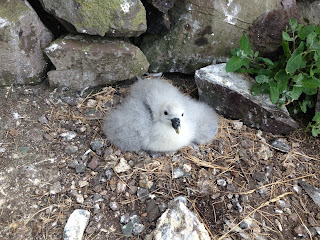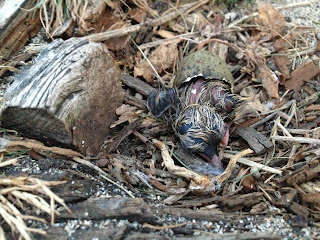 |
| Good news at long last |
 |
| People enjoying Puffins on Staple Island |
 |
| Sand-eels galore |
 |
| Health of a colony - young Puffin returns |
 |
| Hands down - 70,000 Puffin burrows checked and counted |
 |
| A tired but happy Puffin counting ranger team |
Friday 19th July comments: Results from a three-month survey of puffins on the world famous National Trust Farne Islands, off the Northumberland coast, have shown an eight per cent increase in the number of breeding puffin pairs since 2008 when the last census showed a dramatic fall in numbers.
A team of eleven National Trust rangers carried out a full census of the population, which happens once every five years, across eight islands with the final figures showing that there are just under 40,000 (39,962) pairs of nesting puffins.
2003 was the peak year for puffins on the Farne Islands with over 55,000 (55,674) nesting pairs recorded and numbers had been steadily increasing since the 1960s. However the 2008 survey revealed a dramatic crash in numbers by nearly one third to just 36,835 pairs.
David Steel, Head Ranger on the National Trust Farne Islands, commented, "The results of the puffin census come as a real relief following some difficult years for them – with the flooding of burrows last year and a very challenging winter. We had feared that the numbers of puffins would be down again as has happened on other colonies, including those on the Shetland Islands.
“The bad weather during recent seasons has had some impact on numbers, but with a good nesting habitat secured by us and a plentiful supply of food in the area, numbers have been recovering pretty strongly, which is great news for the puffins and other seabirds.”
Extreme weather has had a major impact on puffins in the north-sea in the last couple of years. The 2012 breeding season was hit hard with the second wettest summer on record flooding many burrows, where puffins live.
Earlier this year, just as puffins were returning to the colonies in March, storms resulted in the deaths of thousands of seabirds along the coasts of north-east England and Scotland. Over 3,500 bodies were collected and ringing recoveries suggested that many of the birds involved were breeding adults from local colonies.
Professor Mike Harris from the Centre for Ecology & Hydrology added, "The wreck was unusual in that it occurred when puffins were returning to their colonies and were close to land. It's likely that a very high proportion of the total number of birds that died were found, therefore exaggerating the severity of the mortality.
“The Isle of May puffin population, 100 km to the north of the Farnes, has also shown no sign of a decline in numbers following the winter puffin disaster. Puffin survival over the last winter was not exceptionally low, despite fears after the wreck.”
The unmistakeable puffin with its bright beak and slightly comical walk is a much loved symbol of the British coastline. During the survey, which began in May, the rangers put their arms into holes to make sure that the nests are occupied.
David Steel concluded, “The poor spring weather affected the timing of the breeding season, with the birds that did survive, breeding late”. “However this late start may result in puffins remaining at the colonies until later in the summer than normal, giving people even more opportunity to enjoy watching them.”
For the first time, nest cameras have been inserted into puffin burrows to record the birds’ behaviour in intimate detail. The footage, along with details on how the rangers are progressing with the 2013 puffin census, can be seen at www.nationaltrust.org.uk/puffins or follow progress on twitter at @NTSteely #puffincensus




.jpeg)
.jpeg)
.JPG)



.jpeg)

.jpeg)
.jpeg)
.jpeg)
.jpeg)











.JPG)
.jpeg)
.JPG)





.JPG)
.JPG)
.JPG)
.JPG)









.JPG)
.JPG)
.JPG)



